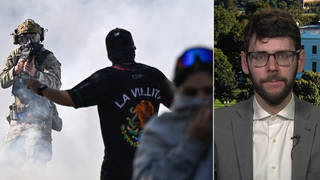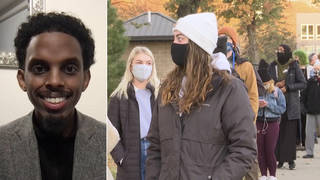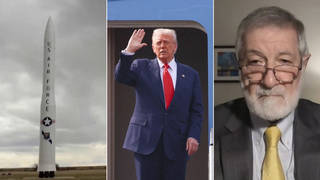
Over a million people have watched an online video shot by a tourist last week showing a New York police officer body-slamming and tackling a cyclist in Times Square. We speak with video activist and archivist Eileen Clancy about the incident and why the city is subpoenaing her organization, I-Witness Video, for hundreds of protest videos shot during the 2004 Republican National Convention. [includes rush transcript]
Transcript
SHARIF ABDEL KOUDDOUS: New York City prosecutors have subpoenaed the group I-Witness Video for hundreds of tapes shot during the 2004 Republican National Convention. The City claims it lost the tapes and needs them to defend itself against charges of wrongfully arresting hundreds of protesters.
Critics say the City might be seeking evidence to avoid further embarrassment. Some of the tapes have already been used to exonerate a protester falsely accused of assaulting police officers. And just this week, a New York police officer was dismissed after he was videotaped body-checking a cyclist during last week’s Critical Mass ride. The video has now been viewed more than one million times on YouTube.
Eileen Clancy is the founder of I-Witness Video. She joins us here in the firehouse studio. Welcome to Democracy Now!
EILEEN CLANCY: Great to be here.
SHARIF ABDEL KOUDDOUS: Eileen, can you start by talking about this latest subpoena from city officials? What is it, and where does it stand right now?
EILEEN CLANCY: There’s actually two subpoenas. And I’m just going to give you a small correction: it’s not from prosecutors, because it’s not a criminal case; it’s in response to civil lawsuits, so we’ve been subpoenaed by the lawyers for New York City, the Corporation Counsel. And they are seeking essentially all the videotapes that we have archived relating to any protests that occurred during the Republican convention.
SHARIF ABDEL KOUDDOUS: Let’s step back a second. So, what is I-Witness Video? Describe what the group does and where you get your — all this archival footage from of the protests.
EILEEN CLANCY: We were formed in the year 2000, after we — basically individuals started to see police attacks at demonstrations, a lot of arrests, seemingly without cause, and we knew that there were a lot of video cameras out on the streets. But it seemed that the video never got to the lawyers. So even though people were arrested, we saw violence, and everyone knew that it was being recorded, it didn’t — all those cameras didn’t really have an impact. So, a couple of people had a similar idea at the same time, and I was one of actually probably over a dozen people who helped to found I-Witness in 2000.
The first action that we did, that we covered, was in the Republican convention in Philadelphia in the year 2000. And our tapes were used to help defend people there. And what we found was — actually, the most important thing, in case anybody wants to do any of this, is to have the clock on your camera set at the right time, because if there’s a police misstatement or there is a confusion about when something happened, that’s very potent.
And one thing that happened during that convention was, a man who was arrested on the streets of Philadelphia and held on a half-million-dollars bail, Terrence McGuckin, a police officer said that he was doing something in a certain period of time in a certain part of town, and we had a tape that showed he was across town and it couldn’t have occurred that way. And even though he had this half-million-dollars bail and even though he had terrible charges against him, the judge basically immediately said, “What are we doing here?” and dismissed the case. And then we knew we were onto something. So —-
SHARIF ABDEL KOUDDOUS: And -— no, go ahead.
EILEEN CLANCY: So we continued to do that at demonstrations over the years, until the — our biggest challenge, the Republican convention in New York City in 2004.
SHARIF ABDEL KOUDDOUS: And these cases — I mean, this was four years ago, the Republican convention in New York. There are still cases now being settled in court right now as a result of I-Witness Video.
EILEEN CLANCY: Yeah, well, what happened was we documented the convention protests in partnership with the National Lawyers Guild, and then we work with them to help defend people who had been arrested at demonstrations. There were 1,800 people arrested. And the New York Times figured out that there were about 400 individuals whose cases were either dismissed or acquitted, solely based on the video. And the reason for that is it contradicted police officers’ statements in such an extreme way that basically the cases were thrown out, or they were considered not believable. And what we learned was, it turned out, much more than we would have imagined, that police were lying in their sworn affidavits about the charges.
SHARIF ABDEL KOUDDOUS: And why is the City claiming it needs the tapes now?
EILEEN CLANCY: Well, what’s happened is they were sued by hundreds of people, and there’s also a class action that people are trying to — the lawyers are trying to get certified, which would include 1,800 people, I guess, who were arrested. I’m not a lawyer, so I’m not going to get every detail correct here.
And so, they’re saying that they need the tapes, because the tapes will help them prove that they had a good reason to arrest people. They’re defending themselves against claims of false arrest. And so, they came to us three-and-a-half years after the convention, which was surprising, because, essentially, we had been all over the pages of the New York Times talking about this, so we figured they knew who we were and that we had videotapes related to this. So, what they’re saying is they want our tapes. And we’ve told them that the tapes — they already have something like 370 videotapes, so why are they coming to us? We’re not suing anybody. If you’re suing the City, then you have to give them anything related to that. But if you’re not a party to the lawsuit, you know, they have to show that they really need it.
SHARIF ABDEL KOUDDOUS: And so, where does that stand right now? Do you have to hand over the tapes or not?
EILEEN CLANCY: We’ve filed a motion to quash, and that means that we’re trying to basically get rid of — there’s actually two subpoenas — we’re trying to get rid of those subpoenas and say that, you know, that the City is not entitled to this material. And so, the judge then will have to make a decision. And the City, of course, is challenging that, as they would.
ANJALI KAMAT: Eileen Clancy, I have a question. Earlier this week, a Critical Mass biker was body-checked by an officer in New York City. Can you talk about what happened? And the incident was also videotaped. Can you lay out what happened, what the police said, and then what the video showed?
EILEEN CLANCY: Yeah. There was the usual Critical Mass bike ride every month in New York. There was a significant police presence at the gathering of the ride. I was at the gathering of the ride. I don’t ride a bicycle, so I don’t go along the ride. If I can’t run along with it, I don’t make it. So, what happened was the bicycle ride went through Times Square, and at some point, one rider was basically tackled by a police officer. A bystander captured that moment on videotape. This was somebody who happened to be right nearby, who was a tourist and just happened to capture it.
And since there are a number of video activist groups that now have been monitoring this ride and monitoring the police conduct, and people were in a good position to basically try to make this videotape have an impact. And the videotape was placed on YouTube. And because it’s a particularly potent example — it’s just from sort of the right angle — you can really see that this rider was going along and the police officer just runs over and slams him. And it just looks like a football maneuver. And it turned out, after this came out in the news media and investigators looked into it and reporters looked into it, that this — actually, this police officer was a former high school football player on Long Island and went to college on Long Island on a football scholarship. So, something was going on there.
SHARIF ABDEL KOUDDOUS: And initially, the biker was arrested and charged, is that correct?
EILEEN CLANCY: He was arrested and charged with assaulting the police officer, which is a very serious charge. So he had two misdemeanor charges, I think, and a lower charge. And the police officer made a statement that he’d been basically run into, deliberately run into, by the bicyclist. And I think you can see from the video that the bicyclist is veering away from the police officer, who’s pursuing this fellow.
SHARIF ABDEL KOUDDOUS: And the officer claimed initially that the biker was veering in and out of traffic and aimed for him, is that what he said?
EILEEN CLANCY: That’s what the police affidavit says, so that’s what was sworn to by the police officer under a penalty of perjury, which in this case would be a felony.
SHARIF ABDEL KOUDDOUS: And in fact, there’s no cars in the video.
EILEEN CLANCY: It doesn’t appear that there are. I mean, I wasn’t there. And what you can see there, it’s just right in front of you. There’s police officers in the road, standing in the middle of the road for some reason. It’s not clear why. And then the bicyclists are going past right there in Times Square.
This videotape, I think, is the first tape that — you know, we’ve been associated with, we’ve helped to get some publicity around it. But it’s the first tape of this kind that we’ve ever been even a little bit near that’s really gone viral, which means that it’s basically exploded across the internet. And it’s been viewed one million times on YouTube. So that was pretty amazing. And it was covered by, you know, all the local television stations and the national news media, and there’s just been tremendous interest in it.
And the question has come up now, what’s going to happen to the charges? This young man is still charged. The charges haven’t been dropped yet. They may be dropped. And also, the police officer actually hasn’t been dismissed from his job; he’s been put on modified duties, on suspension. So his badge has been taken away, and his gun has been taken away, and he’s behind a desk. And so, the police department has to decide and the district attorney has to decide what is to be done. If they determine that the police officer actually lied, you know, what is to be done with the situation here?
SHARIF ABDEL KOUDDOUS: And in our first segment — I just want to go back — we were speaking to an activist in Palestine. They’re protesting the wall over there. Two youths have just been shot, a nine-year-old and a seventeen-year-old. And a lot of what’s happening has been instigated by this other incident where a Palestinian was held by Israeli forces. One of the officers was holding him by the arm, while another pointed a rifle at his leg and shot him with a rubber bullet. This was captured on video. And it was part of — that video was broadcast around the world, and it was part of this Israeli group called Shooting Back, which hands out cameras to Palestinians to capture exactly this kind of incident. Can you talk about that? You know, it’s related to I-Witness Video, this kind of citizen’s journalism.
EILEEN CLANCY: Yes. This group, B’Tselem, which has a project, Shooting Back, has got a magnificent project. I was lucky enough to be on a panel with Oren Yakobovich, who runs that project for B’Tselem. We were on a panel in Istanbul talking about basically watching the police and the army and that sort of thing. And what they do is they hand out cameras to people who are living in these areas where there’s so much trouble and that are militarized areas. And so, what happens is, if you have a news crew in there, you know, the army is a lot less likely to do some of the things that they’re going to do when there’s no news crew there.
So they really have this brilliant project where they hand out many, many cameras. And then, when this violence occurs or these problems occur or these controversial moments occur, it’s possible to create a record. And governments that use physical force and coercion will always also use control of information. And so, using the digital technology, B’Tselem and Shooting Back is able to leverage information to show what really happened and actually put some power back in the hands of people who are the most oppressed.
ANJALI KAMAT: Eileen Clancy, I have a question for you. Moving back to New York City, there’s a piece in today’s paper about the NYPD calling on citizens for amateur video evidence, and New Yorkers — the NYPD is asking for regular citizens to upload video or photo evidence of anything they see that might be suspicious onto their website. What’s your response to this?
EILEEN CLANCY: Well, I have to say, it really seems like a public relations move in relation to this police officer that was caught by an amateur videotape. And what they’re asking is, we are going to have to investigate ourselves, we would like you to give us all the evidence. And it would be different if they were saying, why don’t you give it into the Civilian Complaint Review Board — that’s a watchdog agency — but unfortunately, NYPD has a dismal record of investigating themselves, I would say. And the Civilian Complaint Review Board actually lately put out a report really contending that even when in the very small number of instances they substantiate a complaint against a police officer and they go to the police department for a trial and to get discipline, that they’re disciplined in many fewer occasions than they used to be. So it’s really not clear, you know, what the benefit of that is.
SHARIF ABDEL KOUDDOUS: And so, now we’re just three weeks away from the Democratic convention in Denver. Protests are planned for there. There’s a massive security presence that’s being planned, which we’re also going to talk about later in the program. But what are your plans? What is I-Witness Video’s plans for ’08?
EILEEN CLANCY: Yeah. We’re going to bring a crew to both presidential conventions. It’s pretty exciting. I mean, one of the reasons we’re very interested in covering the conventions is really not sort of because we want sort of bad things to happen, but because what happens is, the focus of the federal government, the law enforcement agencies and all that is very keenly directed at demonstrators. And when you cover these events completely, you’re able to see the patterns. The patterns emerge.
And that’s what we used the Republican convention for in New York. We were able to find out that the police were using agents provacateurs. We were able to find out — we were very surprised — that the district attorney’s office was faking video evidence, police video evidence. And we were able to show that the police officers lied in many instances. So, we don’t know what’s going to happen in Denver and Minneapolis-St. Paul, but, you know, we’re going be there to cover it, and we’ll be hoping that people share their videotapes with us. And if you would like to help us, please send a contribution in through the website.
SHARIF ABDEL KOUDDOUS: And what do you mean, faking video evidence?
EILEEN CLANCY: Well, what happened in the 2004 demonstrations is, in one instance, I discovered that there were two different copies of the same police videotape, and the district attorney had given a defense attorney a copy of a police tape for use at a trial and said, “This is our evidence against you. This is our video evidence against you.” And I found a copy of the police tape with a lot more video, and it then was handed over as evidence. And it turned out that the Manhattan district attorney’s office had removed two sections — and that would have to be deliberate; you can’t do this by mistake — two entire sections of several minutes, the sections that showed that the man who had these charges, Alexander Dunlop, was innocent of the charges. And it was extraordinary. And when that was discovered, the district attorney immediately dropped all the charges.
SHARIF ABDEL KOUDDOUS: We’re talking to Eileen Clancy, the founder of I-Witness Video.












Media Options